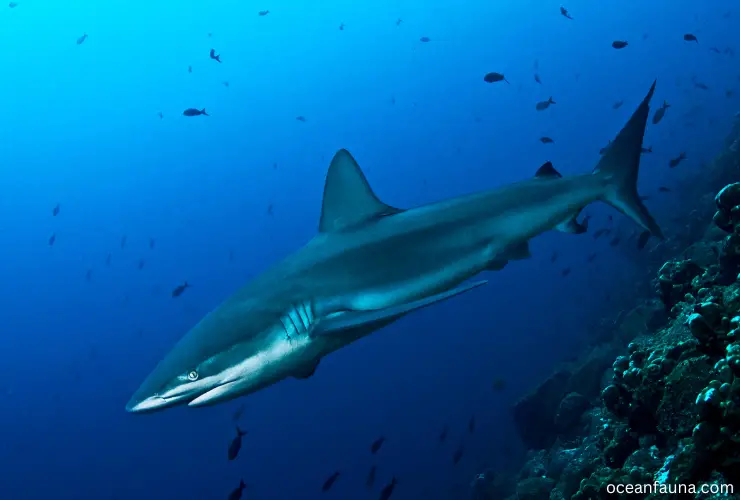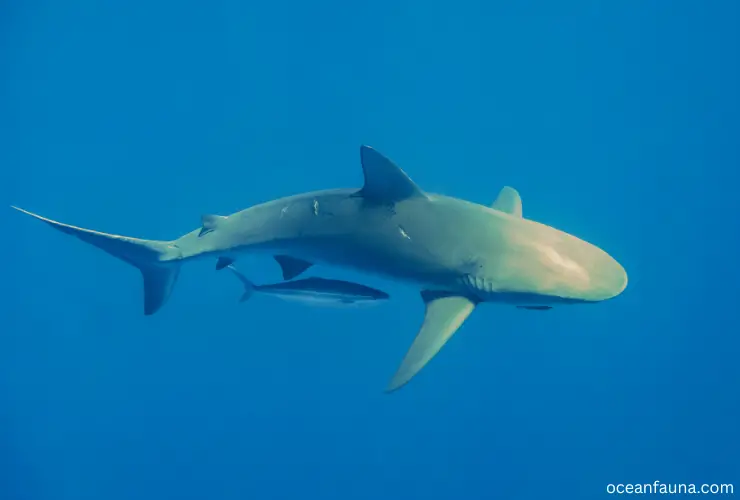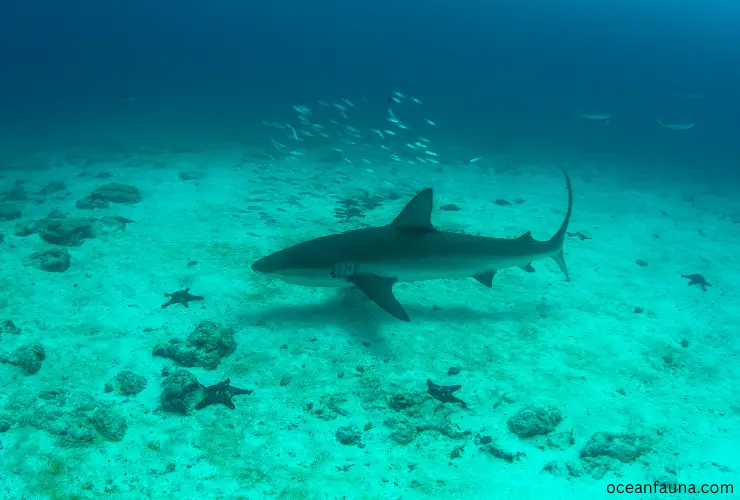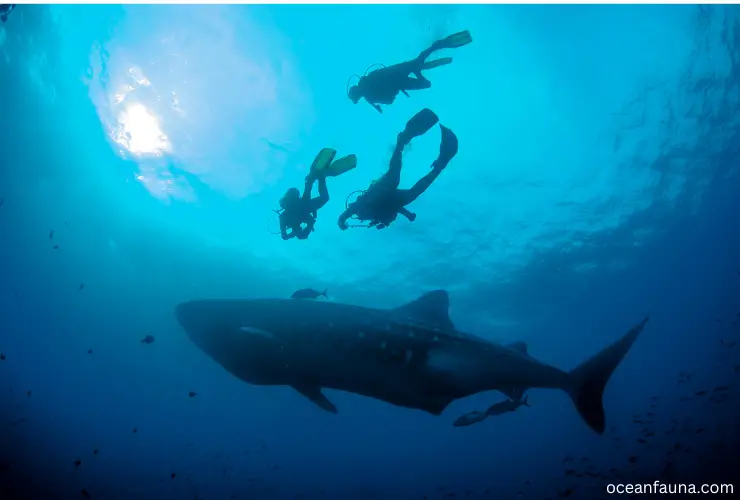The Galapagos shark is a species of requiem shark that is found in warm waters around the world. It is one of the largest members of its family, growing up to 3.7 meters in length and weighing up to 430 pounds. Despite its name, the Galapagos shark can be found in many different locations, including coral reefs and rocky bottoms.
In this article, I’ll take a deep dive into the wondrous world of the Galapagos shark by examining its size, diet, habitat preferences, and behavior patterns. As well as how it interacts with us humans – and what measures we can put in place to ensure these magnificent creatures are safeguarded from potential harm.

About: Galapagos Shark
| Categories | Information |
| Common Name | Galapagos Shark |
| Scientific Name | Carcharhinus galapagensis |
| Family | Carcharhinidae |
| Order | Carcharhiniformes |
| Length | Up to 3.7 meters (12.1 feet) |
| Weight | Up to 430 lbs (195 kg) |
| Diet | Fish, squid, octopus, crustaceans, and occasionally sea lions |
| Habitat | Coastal and offshore waters of the Galapagos Islands |
| Lifespan | Up to 24 years |
| Reproduction | Viviparous (gives birth to live young) |
| Gestation Period | 12 months |
| Litter Size | 4-16 pups |
| Conservation Status | “Least Concern” (IUCN Red List) |
The Galapagos Shark, whose scientific name is Carcharhinus galapagensis, is a species of requiem shark that belongs to the Carcharhinidae family in the Lamniformes order. It is a medium-sized shark that can grow up to 3.7 meters in length, with a grey-brownish color and a long, narrow snout. The Galapagos Shark has a distinguishable, rounded dorsal fin and a long, sickle-shaped pectoral fin.
This species is carnivorous and mainly feeds on bony fish, squid, and octopus. Due to its sharp teeth, the Galapagos Sharks can also consume various crustaceans, small sharks, and rays. They are often found near the ocean floor, in both open and shallow waters, and prefer depths of around 100 meters.
The Galapagos Shark is typically found around the islands of the Galapagos, but it can also be found in all other oceans. They are known to live in a wide range of habitats, including coral reefs, rocky reefs, and deep waters.
Interesting Facts about Galapagos Shark
1. Galapagos Sharks are one of the largest species of requiem sharks, growing 3.7 meters in length.
2. Their unique black-tipped dorsal fin sets them apart from other shark species.
3. These sharks can be found in tropical and subtropical waters around the world, including the Galapagos Islands, California, and Hawaii.
4. They are considered solitary predators but can sometimes be spotted in large groups of up to 100 individuals.
5. Galapagos Sharks feed mainly on other fish, squid, and octopus.
6. The Galapagos Shark has been listed as the Least Concern on The IUCN Red List of Threatened Species due to its wide range and relatively stable population size.
Anatomy of Galapagos Shark
The Galapagos shark’s body structure is designed for efficient swimming and hunting, and it boasts a number of unique anatomical features that make it stand out from other shark species. Here are the details-

Skeletal System
The Galapagos shark has a typical shark skeleton consisting of cartilage instead of bone. Its skeleton is designed for speed and maneuverability, with a streamlined shape and paired fins that help it swim efficiently through the water. Like all sharks, the Galapagos shark has multiple rows of teeth that are constantly replaced throughout its lifetime.
Muscular System
The muscular system of the Galapagos shark is also designed for speed and agility. Its powerful muscles allow it to swim quickly and make sudden turns, making it a formidable predator. The shark’s tail fin, or caudal fin, is particularly important for propulsion and can generate a lot of thrusts to move the shark through the water.
Circulatory System
The circulatory system of the Galapagos shark is a closed system, with blood pumped by a single, muscular heart. Unlike humans, sharks have a number of additional blood vessels and structures that allow them to retain heat in their muscles and organs, enabling them to maintain their body temperature in cold water.
Respiratory System
The respiratory system of the Galapagos shark is particularly unique, as it relies on continuous water flow over its gills to extract oxygen from the water. Shallow-water sharks like the Galapagos shark must constantly swim to maintain this flow, as they are unable to pump water over their gills like some deeper-water shark species.
Digestive System
The digestive system of the Galapagos shark is similar to that of other shark species, with a simple stomach and a long intestine for absorbing nutrients. However, the shark’s jaws and teeth are particularly well-adapted for biting and tearing the prey. Their strong stomach acid helps break down tough, fibrous materials like cartilage and bone.
Nervous System
The nervous system of the Galapagos shark is complex, with a large brain and multiple sensory organs that allow it to detect prey in the water. The shark’s lateral line system, a series of sensory organs along its body, helps it detect changes in water pressure and movement, while its electroreceptors enable it to sense the electrical fields produced by nearby animals.
What Do Galapagos Sharks Eat?

Inquisitive and intrepid, the Galapagos shark is an opportunistic predator that feasts on a variety of prey – including benthic bony fish, squid, octopus, crustaceans, seals and even other sharks.
However, in Galapagos, they are also known to hunt fur seals and sea lions. These fearless hunters act as adept predators and cunning scavengers – hunting for any edible foodstuff that crosses their path!
Their diet is essential for their survival, as it provides them with the necessary nutrients and energy to support their metabolism and growth. These sharks require a high protein diet, as protein is vital for maintaining muscle mass and repairing tissues.
Galapagos sharks are known to use a hunting technique known as ambush predation. They will wait patiently for their prey to come close and then suddenly strike, using their sharp teeth and powerful jaws to capture their prey. These sharks are also known to hunt in packs, working together to surround their prey and attack from multiple angles.
Interestingly, Galapagos sharks exhibit unique hunting behavior in the Galapagos Islands, where they approach groups of resting seabirds and catch them in the water. This behavior is believed to be a learned hunting technique and has not been observed in other populations of Galapagos sharks.
Where Do Galapagos Sharks Live?

Galapagos sharks are found all around the world, but they are mostly concentrated in warm, clear waters near reef systems or oceanic islands. They prefer continental shelf areas and tropical regions of the world’s oceans. These sharks can be found in the Galapagos Islands, Hawaii, South Africa, Japan, and Australia, among other places.
Galapagos sharks are known to be a circumtropical species, meaning they are found in tropical waters around the globe. They prefer warm water temperatures and are commonly found in waters between 20°C and 30°C. These sharks can be found in shallow waters near shorelines and deeper water near drop-offs and reef systems.
The Galapagos Islands are a well-known hotspot for these sharks, with large populations inhabiting the waters around the islands. In fact, they were named after the islands due to their high population there. They are often found in the shallow waters around the islands but can also be found in deeper water.
Galapagos sharks are typically found at depths around 100 meters but have been known to swim as deep as 1,000 meters. They also migrate long distances, with some individuals traveling over 2,000 kilometers.
What Is The Lifespan of a Galapagos Shark?
The maximum lifespan of a Galapagos shark is estimated to be 24 years, making it a longer-lived species of shark.
The lifespan can vary greatly depending on factors such as region, diet, and environmental threats. However, the 24-year lifespan estimation is considered the maximum average for this particular species.
Galapagos sharks are known to be slow-growing, which may contribute to their longer lifespan. Additionally, they have been found to have low reproductive rates, producing only a few offspring at a time. These factors may play a role in their longer lifespan, as they are less prone to rapid reproduction and growth pressures.
How Do Galapagos Sharks Reproduce?
Galapagos sharks are viviparous, meaning that they give birth to live young. The females carry their embryos inside them for approximately 12 months, during which the pups develop inside the female nourished by a yolk sac placenta. The age of the Galapagos sharks at their first reproductive effort is around 10 years.
The mating of Galapagos sharks occurs every two to three years, and after the gestation period, they give birth to a litter of four to sixteen pups. The newly born pups are relatively large, measuring approximately 75-89 cm (30-35 inches) long.
Interestingly, the Galapagos shark’s reproductive strategy involves the mother nourishing her offspring through the yolk sac placenta, which provides them with essential nutrients. This form of intrauterine nourishment for the young is unique to sharks among all other species of fish, making them one of the few that use viviparity to reproduce.
Galapagos sharks are also known for their slow reproductive rate. They produce only a few offspring at a time, and their reproductive cycle is relatively long compared to other shark species. As a result, any disruption to their breeding cycle or environment could severely impact their population, making conservation efforts to protect these creatures incredibly critical.
Are Galapagos Sharks Dangerous to Humans?

Galapagos sharks, although potentially dangerous, pose a low risk to humans. Although they have been known to attack humans, these incidents are rare. Inquisitive, adult Galapagos sharks can demonstrate aggressive behavior when confronted by fishermen. When aroused, they may even go as far as to assault any objects that float on the surface of their domain.
However, the Galapagos shark’s preferred prey is fish, squid, and octopus. They are not known to specifically target humans, and incidents of unprovoked attacks are very uncommon. In fact, there have been very few recorded incidents of attacks by Galapagos sharks on humans.
While Galapagos sharks grow up to 11 feet in length and are formidable predators, they prefer to avoid humans whenever possible. Most encounters with humans are accidental, and the shark may simply be curious about the strange object (such as a surfboard or kayak) floating in the water.
That being said, it is important to exercise caution when swimming or diving in areas where Galapagos sharks are known to inhabit. Avoid wearing shiny objects that may attract the shark’s attention, and do not provoke or antagonize the shark in any way.
What Is the Conservation Status of Galapagos Shark?
The Galapagos Shark has been evaluated for conservation status and listed as the Least Concern on The IUCN Red List of Threatened Species in 2018. This indicates that the species is not currently facing a significant risk of extinction, and its population size and distribution are relatively stable.
The Galapagos Shark is a species of requiem shark found in tropical and subtropical waters of the Pacific Ocean, including the Galapagos Islands, southern California, and Hawaii. They are known to inhabit shallow and deep waters and are usually found in schools.
Although the Galapagos Shark is not threatened with extinction, it faces several threats that require ongoing conservation efforts. One of the major threats is commercial overfishing, as the species is often caught as bycatch in fisheries targeting other commercially valuable species such as tuna and swordfish.
It is also hunted for its fins, which are highly valued for shark fin soup, a delicacy in some Asian countries.
The Galapagos Shark has a slow growth rate, late maturity, and low fecundity, which make it vulnerable to overfishing. Additionally, its range and habitat are limited, which makes it more susceptible to local population declines.
Conservation efforts for the Galapagos Shark include regulating fishing and banning shark finning in many countries, and establishing marine protected areas where the species can thrive.
With continued conservation efforts, it is hoped that the Galapagos Shark will remain a species of Least Concern and will continue to play its important role in the ecosystem of the Pacific Ocean.
Conclusion
Now you have a detailed analysis of Galapagos sharks. I have discussed everything from its physical description to conservation efforts and interesting facts about them.
Galapagos sharks are large predators but pose very little threat to humans and are mostly docile in nature. Despite this, exercise caution when swimming or diving in areas where these sharks may inhabit.
Apart from all the discussion, if you have any further queries about them, just let me know.

